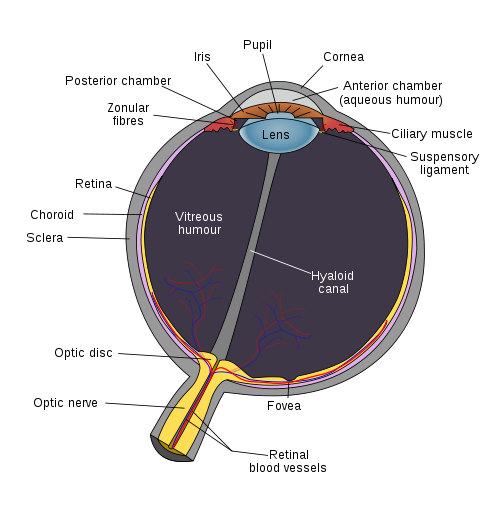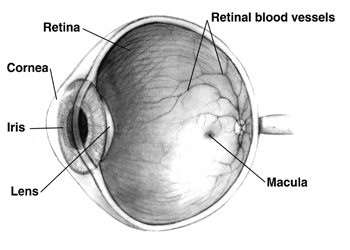Macular Degeneration Types, Causes, Symptoms, Prevention
It is the leading cause of blindness among Americans older than 50 years and affects more than 20% of Americans over the age of 60. Macular degeneration is a major age-related problem in developed countries and as yet there is no cure. The more common type develops very slowly and many people do not even know that they have it in the early stages.
What is macular degeneration?
Macular degeneration is a chronic eye condition where the light sensitive portion of the eye gradually deteriorates. It leads to central vision loss over time. Most cases occur in older people and the cause is not always clearly understood. It is believed to occur due to age-related changes in the eye tissue, hence the term age-related macular degeneration (AMD). There are two types – dry and wet – with the dry type being more common. The dry type develops over years or decades while the wet type develops over months.
A number of risk factors have been associated with macular degeneration, many of which are similar to those for cardiovascular disease. Family history is one of the most important of these risk factors and certain genes have been identified as playing an important role in its development. Age-related macular degeneration is not curable. There are several measures to slow down the progression of the disease to some extent but the tissue deterioration cannot be reversed.
Types of Macular Degeneration
There are two types of age-related macular degeneration:
- Dry (non-exudative)
- Wet (exudative)
Dry Type
Non-exudative or dry macular degeneration accounts for about 90% of all cases.The macular tissue atrophies with no signs of inflammation. Small yellow to white particles known as drusen forms under the macular are believed to be the cause of tissue deterioration and degeneration.
Wet Type
Exudative or wet macular degeneration occurs when new abnormal blood vessels form behind the macula. These blood vessels break and leak fluid which separates the macula from underlying tissue.
Causes of Macula Degeneration
The inner lining of the eye is known as the retina. It is light sensitive which allows for the sense of vision. Light that strikes the retina stimulates photoreceptors within it. In turn these receptors elicit electrical signals that are carried by nerves to the brain. The signals are then deciphered by the brain giving the sense of vision.
The are at that back of the eye on the retina is known as the macula. Light has to strike the macula for there to be clear central vision. A small area within the macula is the fovea. It has a very high concentration of cones, a type of photoreceptor. The fovea is responsible for the highest resolution vision where the clearest images can be perceived.
Macular degeneration affects the macula of the retina. It is believed to be due to oxidative stress as a result of light and oxygen combined. However, not every person is prone to developed age-related macular degeneration. Some people are at a much higher risk than others.
Risk Factors
The exact cause of age-related macular degeneration, particularly the more common dry type, is not known. However, it is strongly associated with genetic factors and is therefore thought to be an inherited disease with late onset. The main risk of developing macular degeneration is associated with specific genes – CFH gene (chromosome 1), BF (complement factor B) gene and C2 (complement component 2) gene (chromosome 6), and LOC gene (chromosome 10).
Other risk factors include:
- Age – the risk increase significantly after the age of 50 years.
- High blood pressure (hypertension) – wet-type
- High blood cholesterol levels
- Cigarette smoking
- Obesity – increases risk of early-onset AMD and more severe AMD
- Poorly balanced diet – low in fruit and vegetables
- Cardiovascular disease – diseases of the heart and blood vessels
Signs and Symptoms
The early signs and symptoms are not always obvious. When noticed, many people just associate it with poor eyesight in the latter years of life. Other conditions like cataracts are sometimes suspected before macular degeneration. It is therefore important that the eyes are regularly checked by an eye care professional for early diagnosis. These signs and symptoms include:
- Dimming of the vision – people with AMD need brighter light to see.
- Reduced brightness of colors
- Difficulty adapting to changing levels of light
- Blurring of objects
Many older people ignore these symptoms and try to correct it with their eye glasses believing that it is a common refractive error of the eye. As the disease progresses, more specific signs and symptoms become evident:
- Difficulty recognizing people’s faces.
- Hazy vision particularly of the central vision.
- Blind spot in the center of the visual field.
- Crooked vision.
- Visual hallucinations.
Treatment for Age-Related Macular Degeneration
There is no medical treatment for macular degeneration. Vitamin supplements may help to slow the progression as discussed under prevention. Surgery to implant telescopic lenses in the eye is only considered for some cases of advanced macular degeneration. With the wet type on the other hand there are several drugs and treatments that can be considered. Early diagnosis is therefore important. This includes drugs which are injected into the eye to stop the growth of abnormal blood vessels. Some of these drugs require light exposure to be activated (photodynamic therapy). Another option for wet macular degeneration is the use of laser therapy to destroy the abnormal blood vessels (photocoagulation).
Prevention of Macular Degeneration
Many of the risk factors mentioned above are modifiable. This means that it can be stopped or undone. By doing so macular degeneration can be prevented to some degree, delayed or at least slowed down. This includes:
- Losing weight and maintaining a healthy body weight.
- Quitting tobacco smoking.
- Eating a diet that is rich in fresh fruit and vegetables.
- Choosing to eat more fish.
Certain vitamins and minerals are known to help in slowing down the progression of macular degeneration. If taken early it may have some benefit in delaying the onset of the disease. This includes vitamin C, vitamin E, beta carotene, zinc and copper. Research conducted by the National Eye Institute in the United States found antioxidant supplements containing these micronutrients to be helpful in slowing down the progression of age-related macular degeneration (dry type).





